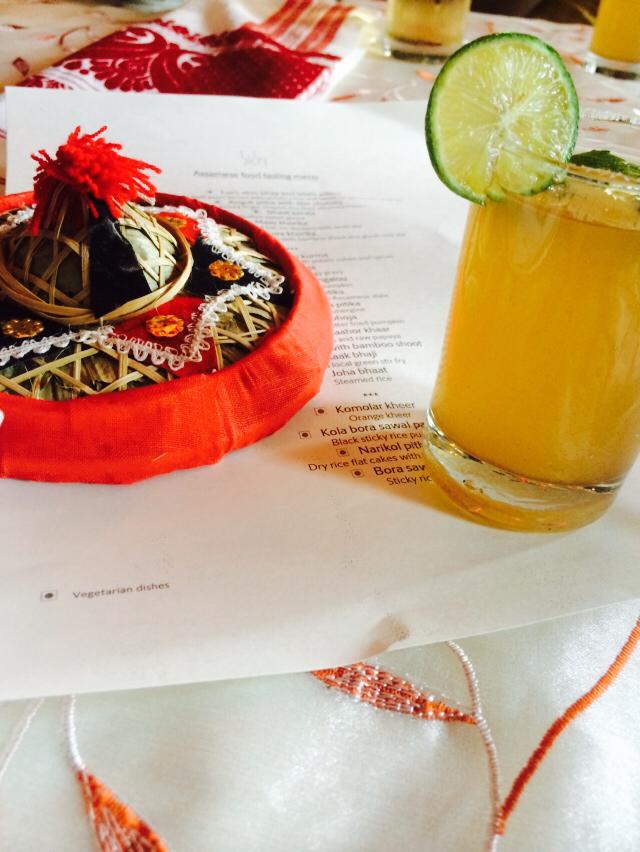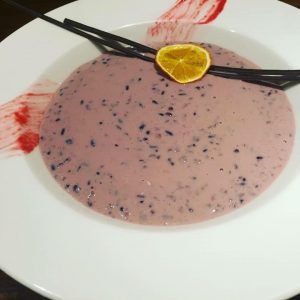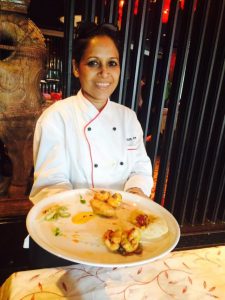An Assamese Awakening
Assamese cuisine has been an vastly unexplored entity on my palate, apart from the one meal which I had been invited to by my journalist friend Purba Kalita years ago, which had a couple of Assamese specials, including one of its best-known dishes, Maasor Tenga, a sour fish curry.
What I remembered was that the food was typical of its community: delicate, understated, exotic, rare-to-find (unfortunately!) and yet standing distinctly tall and strong, like the rest of its North East Indian counterparts.
So, when I landed an invite to an Assamese pop-up food festival at Bidri, the Indian speciality restaurant at Marriott Hyderabad, I was hugely excited, as well as intrigued. Well-done, chef Yogender Pal (executive chef Marriott Hyderabad) was my first thought, for pulling off this feat on the second edition of their Himalayan food trail (the first one was a Himachali pop up a couple of months ago). The intriguing part was that Hyderabad, as most of us know, is best-known for its kacchi gosht biryani and its seasonal haleem obsession, and the fact that Hyderabadis in general, choose biryani & haleem over any other cuisine, is part of folklore.
Curating this festival was Assamese food consultant and blogger, Kashmiri Barkakati Nath, who, as we discovered on a memorable afternoon over a splendid Assamese meal, wore more feathers in her cap, such as her access to some rare English baking recipes, as an young tea plantation wife, from their Burmese cook, (known as Moghs, and now extinct). Moghs used to serve the British tea plantation owners and were noted for their excellent culinary skills.
“The fluffiest of soufflés, vous le vents and breads I had the privilege of learning from him, and consider him my guru. He belonged to the old British school of measuring in pounds and ounces, and he used to keep exhorting me to write down the recipes, as he would not be there for long, being quite aged,” recounted the charming Kashmiri at our bloggers table, which sat down to lunch. The elegant Assamese touches of their white-and-red hand-woven ‘gamchas’ and miniature bamboo woven hats (worn by peasants) added to the ethnic ambience.
To start the meal, we were served the refreshingly tangy drink Thekera Tengar Sorbot, made of thekera, (dried mangosteen closely resembling the kokum, which is grown in Assam), a pinch of rock salt, and sugar.
For starters, there was a humungous plating of:
- Luci, Aloo Bhaji and Bilahi Ambol (the same as Luchi Aloo Bhaja in Bengali cuisine along with a smattering of tomato chutney)…
- Anguli Pitha (steamed finger-shaped rice flour cakes which are sautéed with vegetables and served like a snack)
- Maas Khorika (boneless fish cubes on bamboo skewers) served with a yummy fermented mustard dip, as pungent as wasabi.
- Kukura Khorika, grilled chicken served with Bhoot Jolokia (ghost chilli) dip.
- Bhaat Kerala, teasel gourd (the spiny, green vegetable part of the gourd family) which was stuffed with aloo bharta
While the starters were all good, what highlighted their taste was the dips which came with them, especially the Bhoot Jolokia one which has the world’s hottest chilli, or among the hottest three chillies. Short and red, it packs a pumch, but has an unique flavour of its own. So, the dip had the chilli, bamboo shoots and chopped coriander & was deadly addictive!
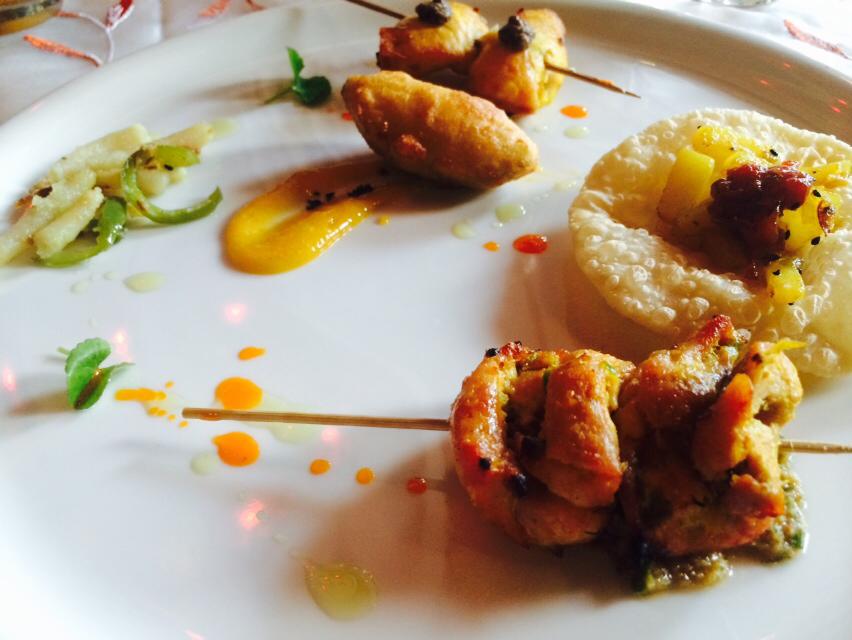
Starters: Luchi-Aloo Bhaji, the finger-sized Pitha, Grilled Chicken on skewers. Kerala Bhat (teasel gourd stuffed with mashed potato)…
So was the fermented mustard Kahudi, which is fermented for a couple of days with a souring agent, wrapped in a banana leaf . This was as pungent as wasabi and decidedly delicious too.
For main courses, again a wide variety:
- Aloo Pitika and Baingan Pitika, basically Aloo and Baingan bharta seasoned with mustard oil, onions and chillies
- Lou Bhoja (rice batter crisply fried pumpkin)
- Xaak Bhaji (sautéed fiddlehead greens, which closely resembled spinach in its cooked, wilted form, except that this was more fibrous
- Omita Maahor Khaar (khaar is usually part of every Assamese meal and consists of lentils and cooked raw papaya)
- Maangso Rongalou
- Til Kukura
- Maangso Aloo Korma
- Maasor Tenga (traditionally rohu fish, but fish used in this one was murrel, cooked in a light, sour gravy with the addition of elephant apple.)
- Joha Bhaat or steamed rice
In the main courses, I found the Maangso Aloo Korma and the slightly sweetish chicken curry cooked with sesame, quite appealing.
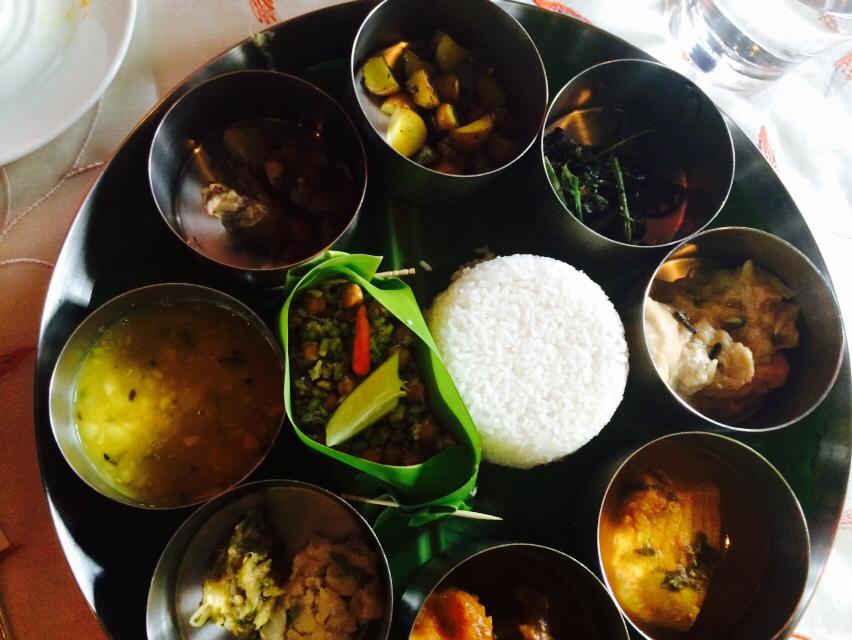
The main course had rice, masoor dal, potato\eggplant mash, fiddlehead greens, a crunchy and fresh sprouts salad, two kinds of lamb curry, Maasor Tenga (fish sour gravy) and a chicken curry in til paste
Time for desserts and there were surprises galore. The plating was of three delights, Komalor Kheer (orange kheer), Narikol pitha and last but not the least, Kola Bora Sawal Paiyok. The last one, a pudding made of sticky black rice (which turns light purple on cooking with milk) was superlative. Apart from the nutty, grainy texture what I enjoyed about the black rice pudding was its character, smooth and not too sweet and with a rare flavour. According to chef Kashmiri, black rice is uncommon, grown in upper Assam and priced at about Rs 200 per kilo, which is expensive considering Assam grows a lot of rice.
Black sticky rice pudding was a revelation!
What I took away from this amazing meal was a cuisine unique with its own chilli, the Bhoot Jolokia, its souring agents and its rich in technique and deceptively simple flavours. It was also a privilege to have interacted with Kashmiri, the extremely gifted and gracious hostess of a wonderful afternoon, and to have got a whiff of plantation life, with its Assam tea smacking of English high teas, and at the same time honouring Assamese ethnicity and bringing it to the mainstream collective consciousness.
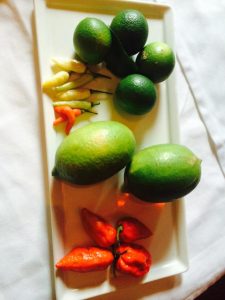
Ingredients common to Assamese cuisine include the fiery Bhoot Jolokia, the red chilli peppers, counted among the hottest peppers in the world, (foreground in the pic), the other chillies (yellowish) are equally hot, Lemons are the most popular souring agents and so are mangosteen and elephant apple…
This was a meal I will not forget for a long, long time…

